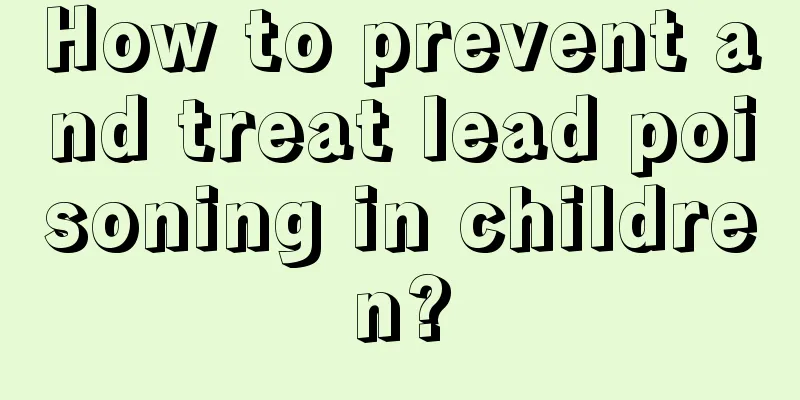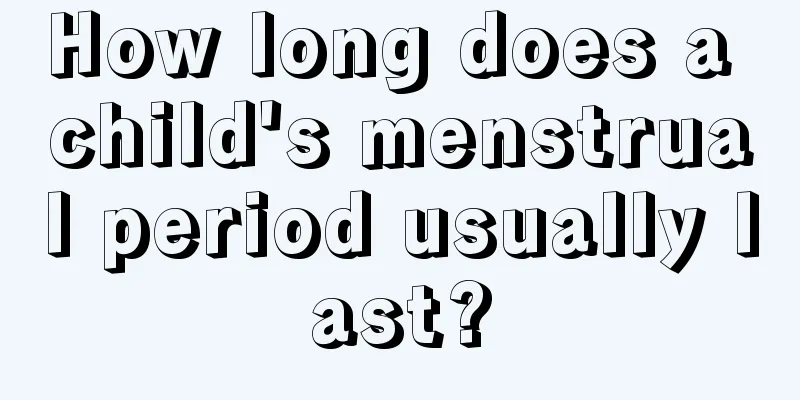How to prevent and treat lead poisoning in children?

|
Children's organs and functions are not fully developed yet, so they are easily susceptible to diseases. Children, in particular, are ignorant and prone to frequently chewing on toys, bed frames, or even some lead-containing paint layers, or lead-containing toys, etc., which may lead to lead poisoning. Lead poisoning is very harmful to children and can easily lead to abnormal intellectual development, anemia, etc. So what is the treatment for lead poisoning in children? Lead poisoning in children needs to be discovered and treated in a timely manner, otherwise it is easy to cause irreversible consequences. Therefore, family members should always pay attention to their children, try not to keep lead-containing items at home, and go to the hospital regularly to check the lead content. So if lead poisoning occurs, what is the treatment method for children? Treatment of lead poisoning in children Lead poisoning in children is mostly caused by ingestion through the digestive tract. Infant poisoning often results from licking lead-containing powder off the mother's face, sucking lead-containing ointment applied to the mother's nipples, or the breast milk of a mother with lead poisoning. When children's deciduous teeth erupt, they may be poisoned by chewing on lead-containing paint on bed frames, toys, etc. Children with pica may develop lead poisoning by swallowing large amounts of paint that has fallen off floors or walls. In addition, eating acidic food cooked or placed in lead-containing containers, drinking or eating water and food contaminated by lead, and accidentally taking excessive amounts of lead-containing medicines can all cause acute poisoning. Symptoms of lead poisoning in children : "poor appetite, abdominal pain, anemia, hyperactivity, inattention" etc. have all been described as being related to lead poisoning, but these symptoms are not specific to lead poisoning. When the blood lead concentration exceeds 100 micrograms/liter, it will cause harm to health, but the child may not have any clinical symptoms at this time. Therefore, it is best to test your child's blood lead level once when he or she is 1 year old and again when he or she is 2 years old. If the above-mentioned symptoms of lead poisoning occur, the diagnosis can be confirmed through the following lead poisoning detection methods: 1. Blood lead testing is usually used. The methods for blood lead detection can be divided into direct and indirect methods; 2. Among the direct methods, the more sensitive and accurate ones are the atomic absorption graphite furnace method and the anodic stripping voltammetry method, and the anodic stripping voltammetry method is the most accurate. 3. The indirect method mainly involves the determination of erythrocyte zinc protoporphyrin (ZPP). When the blood lead level is high, the erythrocyte zinc protoporphyrin often increases. Therefore, the blood lead level can be indirectly reflected through the zinc protoporphyrin determination. However, due to the many influencing factors and the imprecision, this method has been basically abandoned. 4. In addition to blood lead, hair lead, urine lead, bone lead, tooth lead, etc. can also be measured, but some of these methods are more complicated and time-consuming, and some have poor accuracy, so they cannot be promoted and applied. Currently, the most recognized method for diagnosing lead poisoning is blood lead. Treatment of lead poisoning in children
The treatment plan for childhood lead poisoning should be determined based on the blood lead level, and different treatment measures should be taken for different levels. The basic principles for treating lead poisoning in children are: prevention first, nutritional intervention. Regardless of the level of lead poisoning, the first thing to do is to conduct health education, improve the environment, wash hands frequently, avoid eating foods high in lead, and eat a balanced diet. Mild to moderate lead poisoning: Focus on health education and environmental intervention, wash hands frequently, and stay away from lead-contaminated environments; at the same time, carry out nutritional intervention treatment and supplement minerals such as calcium and zinc, trace elements, and vitamins when necessary. Check regularly. Severe and extremely severe lead poisoning: Lead-removing drugs such as calcium disodium edetate (CaNa2EDTA), dimercaptosuccinic acid (DMSA), and dimercaptopropanol (BAL) should be used. Please note that these drugs have significant side effects and can damage organs such as the heart, liver, and kidneys. They can also cause disorders of minerals, trace elements, and water and electrolytes. Therefore, hospitalization is required when using these drugs. Changes in liver and kidney function, electrocardiogram, water, electrolytes, and trace elements should be monitored. Attention should be paid to protecting liver, kidney, and heart function, promptly correcting water and electrolyte disorders, and supplementing minerals and trace elements such as calcium, zinc, and iron. Ways to prevent lead poisoning in children
Under the current circumstances, parents can still reduce the harm of lead poisoning to their children if they do the following: 1. Educate your baby to develop a good habit of washing hands frequently, especially before eating; 2. Help your baby cut his nails frequently, as the nail crevices are particularly prone to hiding lead dust; 3. Regularly clean your baby's toys and other items that may be put in the baby's hands or mouth; 4. Let your baby eat on a regular basis, as the absorption rate of lead in the intestine will increase exponentially when the baby is on an empty stomach; 5. Ensure that your daily diet contains sufficient amounts of calcium, iron, zinc, etc. 6. In an environment without significant lead pollution, children with mild lead poisoning do not need to take lead-removing medicine or health products, but should drink 1 to 2 cups of milk every day. Let your children eat less foods with high lead content, such as preserved eggs, popcorn, etc., and less canned food and drinks. For the very few children with severe lead poisoning who really need treatment with lead-removing drugs, they should be hospitalized for treatment in a timely manner. Currently, the preferred lead-removing drugs in clinical practice are disulfide succinic acid and calcium disodium edetate, and treatment needs to be carried out under the guidance of a child health expert. Recipe to prevent lead poisoning in children: 1. Milk. Function: Rich in nutrients, the protein in milk can combine with lead in the body to form an insoluble compound, thereby reducing the body's absorption of lead. Dosage: 250~750 ml of fresh milk per day. 2. Kiwi. Function: It can promote the production of body fluids, quench thirst, eliminate stagnation, and replenish a large amount of vitamin C. Vitamin C combines with lead to form water-soluble and non-toxic salts that are excreted from the body with feces. Dosage: 2 to 3 kiwis per day. Eat as fruit. Drink 100 to 200 ml of kiwi juice every day. Note: Kiwi fruit is cold in nature, so people with weak spleen and stomach or stomach problems should not eat too much. Eating too much will cool the spleen and stomach. 3. Bitter melon, soybean and pork ribs soup. Function: Nourishes yin and replenishes qi, clears away heat and detoxifies, and removes lead. Ingredients and dosage: 300 grams of bitter melon, 25 grams of soybeans, 200 grams of spare ribs, and 2 slices of ginger. Cooking and eating methods: Remove the pulp of the bitter melon and slice it. Chop the pork ribs into pieces and blanch them to remove the fishy smell. Put all ingredients into a pot, add appropriate amount of water, boil over high heat then simmer for 1 hour over low heat, season with salt and it is ready to eat. After reading the above question about how to treat lead poisoning in children, I believe everyone has some knowledge and understanding of the symptoms and manifestations of lead poisoning. In fact, lead poisoning needs to be discovered and treated in time. In addition, parents should pay attention to the above precautions to reduce the discovery of lead poisoning and its impact on children, etc., and remember to take their children to the hospital for examination and treatment in time. |
>>: What are the reasons for children being too low in weight and how to treat them
Recommend
For children with tic disorders, psychological treatment is very important!
Nowadays, many parents and teachers do not pay mu...
Thick mucus that can't be blown out
Mucus is a liquid secreted from the human nasal c...
What food is good for children with colds and fever? These seven are very effective
When a child catches a cold or has a fever, timel...
Can an eight month old baby crawl?
Everyone can crawl, but this only applies to adul...
Do newborns need to be burped?
The digestive system of a newborn baby is not per...
What to do if your baby has scrotal effusion
There are many common problems for babies. The ch...
Is it good for children to use buckwheat pillows?
When many children are young, their mothers don’t...
How to treat IGA nephropathy in children?
Some children suffer from certain kidney diseases...
Treatment of neonatal hemangiomas
Neonatal hemangioma is undoubtedly a very common ...
Treatment for yellow urine in newborns
We may know that there are many reasons for the y...
What to do if infants and young children have intestinal gas
I often hear some elderly people say that hernia ...
11 simple ways to make your baby smarter
1. Talk to your baby more. 2. Touch your baby mor...
Lymph nodes behind the baby's ears
Swollen lymph nodes behind the ears is a common d...
What is going on when a child's heart beats fast? Pay attention
After she had a baby, the parents could be said t...
Baby's pinky finger is bent
Some mothers will find that their baby's litt...









